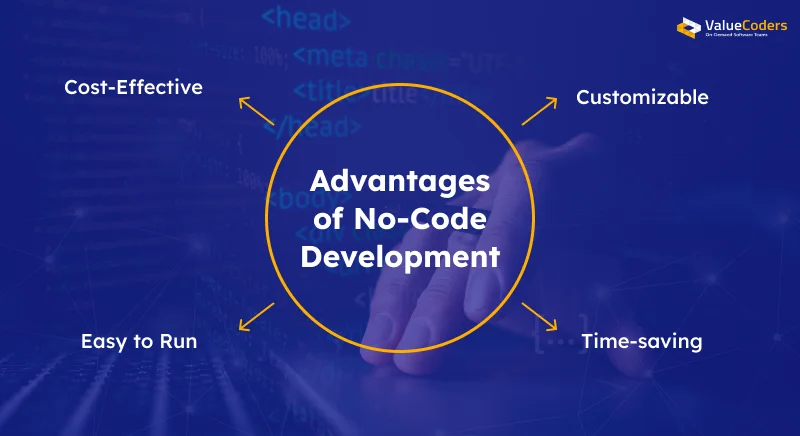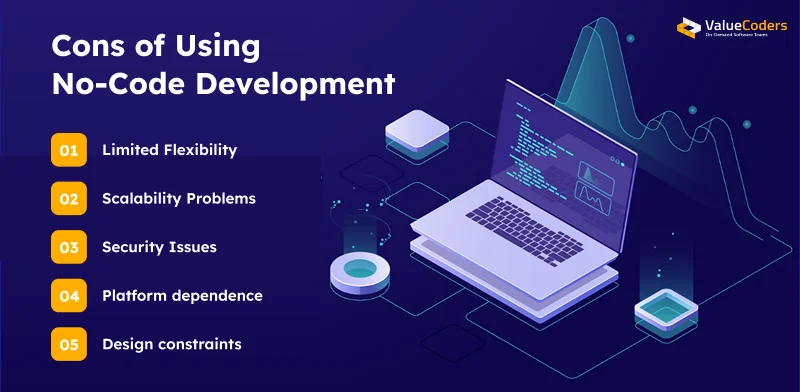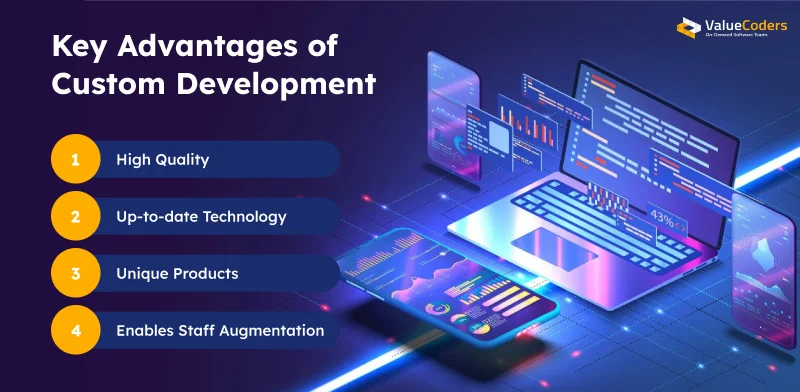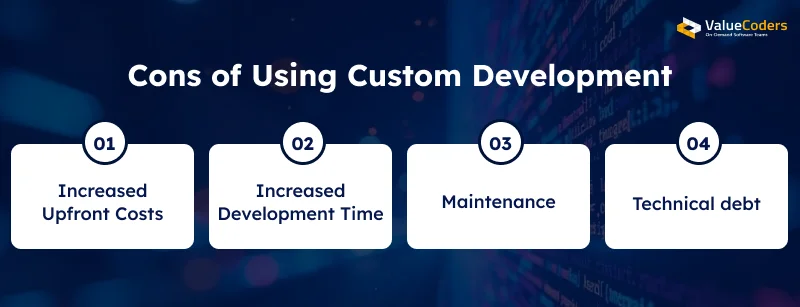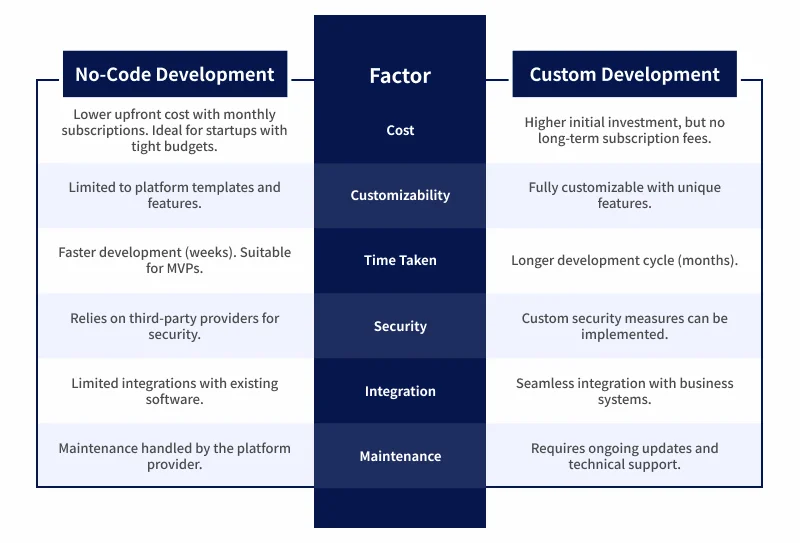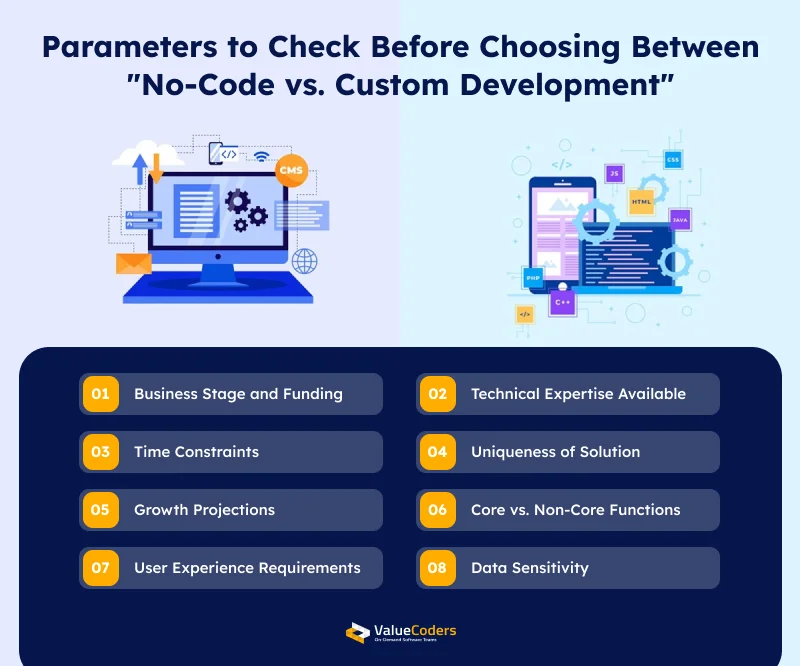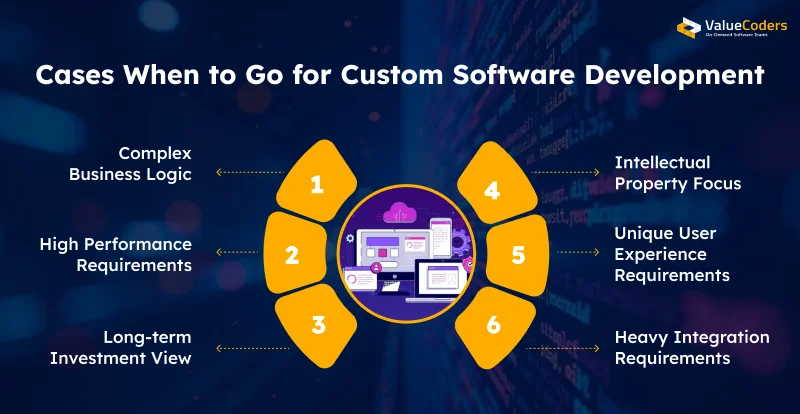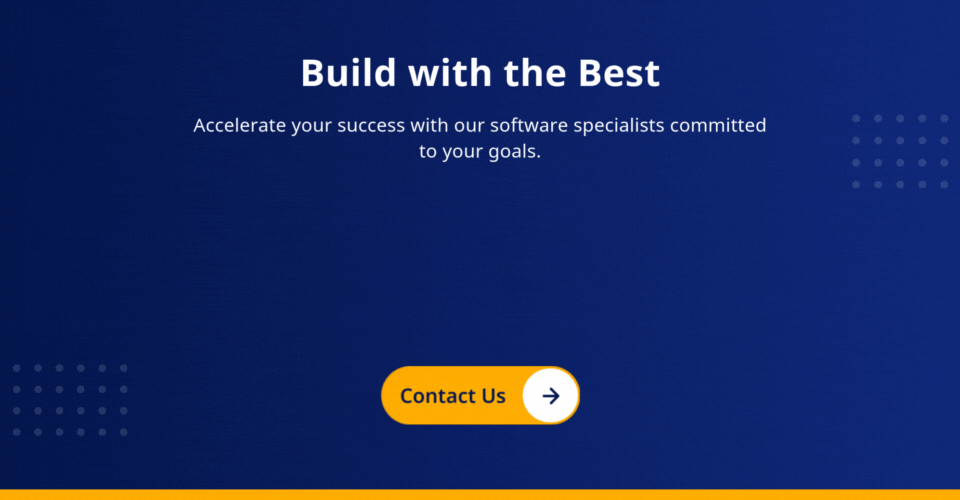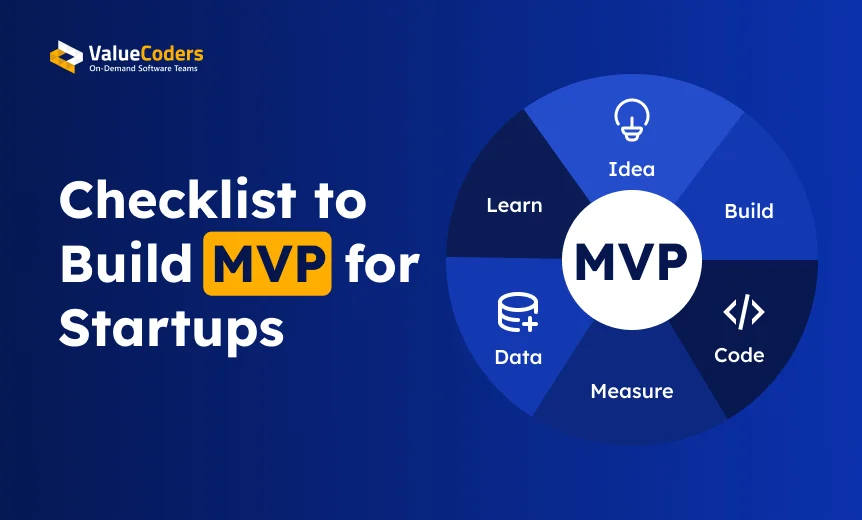Nowadays, to start a business is not as easy as it seems to be. Today’s market is highly competitive, and it becomes important for each entrepreneur to select the most suitable technology before starting his/her own startup.
In 2025, for startups, we have two best choices i.e., no-code development and custom development.
No-code development platforms shorten development time by 90% compared to custom development. However, both methods possess their advantages and disadvantages.
According to a Gartner report, 70% of new business applications will be utilizing no-code/low-code technologies by the end of 2025. Moreover, the market for these technologies will grow to $36.43 billion by 2027.
The above figures show how no-code development would be advantageous for startups in the near future. Let’s understand both approaches in detail, where we will break down their benefits, drawbacks, and key differences of no-code vs. custom development.
An Overview of No-Code Development
No-code/low-code solutions enable users to develop applications without coding or with less coding. The solutions employ visual interfaces, drag-and-drop features, and pre-configured templates to build efficient software in a short span of time.
Top Advantages of No-Code Development
Startups can reduce development time by as much as 80% while enabling non-tech founders to turn their idea into reality. This app-building revolution has made doors that were once inaccessible to individuals without coding knowledge swing open.
- Cost-Effective: No-code platforms save startup founders from paying for a startup app development team. A majority of platforms have low, monthly subscription charges, which fits well within small startup budgets.
- Easy to Run: The non-technical, user-friendly interface enables founders to create and design applications without learning to code. Most platforms are equipped with pre-designed templates, in-built tools, and free customer support.
- Time-saving: Though restricted in comparison to bespoke solutions, no-code platforms enable the user to customize templates, embed third-party services, and integrate automation.
- Customizable: While limited compared to custom-built solutions, no-code tools allow users to personalize templates, integrate third-party services, and add automation.
Drawbacks of No-Code Development
Though they are easily accessible, no-code platforms have limitations inherent in them that can dampen innovation during the most critical growth phases. Most founders learn about these limitations after investing substantial time and resources.
- Limited Flexibility: No-code platforms offer flexibility, but can’t rival the distinctiveness of custom software. Startups requiring sophisticated features might find no-code platforms too limiting.
- Scalability Problems: When a business expands, no-code solutions can grapple with large traffic, advanced integrations, or data-intensive applications.
- Security Issues: No-code applications depend on third-party platforms, thus businesses have to trust providers with their data and security protocols.
- Platform dependence: Tying to a single vendor poses risk if they raise prices or go out of business.
- Design constraints: Templates and modules can limit expression of individuality in a brand.
Get free consultation and let us know your project idea to turn it into an amazing digital product.
An Overview of Custom Development
Custom software development entails developing applications from the ground up using programming languages and frameworks selected specifically for your requirements. This method takes top dedicated developers but grants full control over the end product.
Benefits of Custom Development
Custom software solutions give the ultimate competitive advantage through unique features that competitors just can’t copy. This basis of proprietary technology becomes more valuable as your startup grows.
- High Quality: Custom-developed software guarantees improved performance, stability, and security, as each feature is tailored to the business’s requirements.
- Up-to-date Technology: Developers can incorporate the latest tools, frameworks, and AI-powered features to make the product stay competitive.
- Unique Products: In contrast to no-code solutions that rely on pre-built templates, custom development for startups enables them to build a fully customized application as per their audience.
- Enables Staff Augmentation: Startups can outsource freelance or remote developers to assist in-house teams, enabling projects to be delivered at a quicker pace.
Also Read – Why Custom Software Development Saves Enterprises Millions in the Long Run
Disadvantages of Custom Development
The path to custom software is lined with unexpected hurdles, from unforeseen development costs to quietly amortizing technical debt. Even fully funded startups need to think hard about these possible pitfalls.
- High Upfront Costs: Custom development lets you pay for experienced developers, which can be costly, particularly for early-stage startups.
- Increased Development Time: Developing an application from scratch is always time-consuming as it takes a few months to more than one year.
- Maintenance: In contrast to no-code platforms where the platform provider takes care of updates, custom software needs constant monitoring and maintenance.
- Technical debt: Bad implementation can result in future issues.
Need a fast launch? Our no-code specialists have delivered 500+ solutions with 40% faster time-to-market.
No-Code vs. Custom Software Development: Key Differences
Beyond surface-level distinctions lie fundamental approaches to building a software product. Understanding these core differences helps you align the development strategy with long-term business objectives and available resources.
Let’s find the key differences before choosing the best development approach for startups:
1. Cost
- No-Code: Monthly subscription fees typically range from $25 to $500 per month depending on features. Initial setup costs are minimal, but costs add up as you scale users or add premium features.
- Custom Development: Upfront costs can range from $10,000 for simple applications to $250,000+ for complex solutions. While expensive initially, you own the result with no recurring platform fees.
Startups should consider total cost of ownership over 3-5 years, not just initial expenses. No-code often wins short-term but may become more expensive as you scale.
2. Customizability
- No-Code: Offers good flexibility within platform limitations. Basic applications are simple to customize, but unique features may be impossible or require workarounds.
- Custom Development: Nearly unlimited customization potential. You can create exactly what you need and adapt it as your business evolves.
The right choice depends on how unique your needs are. Standard business processes work well with no-code, while novel approaches may require custom solutions.
3. Time taken to create a product
- No-Code: MVP development typically takes 2-8 weeks, with some simple applications ready in days.
- Custom Development: Timelines range from 3-12 months for initial versions, with complex projects taking longer.
Speed to market advantages of no-code can be significant for testing business ideas or beating competitors to launch.
4. Security concerns
- No-Code: Security depends on the platform provider. No-code and low-code development services maintain good security, but you have limited control and visibility.
- Custom Development: Gives complete control over security measures but requires expertise to implement properly. Security flaws from poor development practices create major risks.
For startups handling sensitive data or facing regulatory requirements, custom development often provides better security options.
5. Integration into other systems
- No-Code: Most platforms offer pre-built integrations with popular services. Custom integrations may be limited or require third-party tools like Zapier.
- Custom Development: Can integrate with any system that provides access methods. Custom APIs can be built specifically for your integration needs.
Consider your current and future tech stack when deciding. Complex integration needs often push toward custom development.
6. System support & maintenance
- No-Code: Platform providers handle infrastructure, updates, and technical maintenance. You focus on content and configuration.
- Custom Development: Requires ongoing development resources for updates, bug fixes, and security patches. This creates additional long-term costs and responsibilities.
Maintenance costs for custom development usually run between 15-20% of initial development costs annually.
Protect your startup with enterprise-grade security and custom development trusted by Fortune 500 and fast-scaling startups.
Factors to Consider When Choosing Between No-Code vs. Custom Development
Before deciding on your startup development approach, you must consider the following key factors:
1. Business Stage and Funding
Bootstrapped startups often benefit from no code to conserve cash, while funded startups might invest in custom development for long-term advantages.
Winner: No-code
2. Technical Expertise Available
Your team’s skills matter. No tech expertise favors no-code, while strong technical founders might leverage custom development effectively.
Winner: No-code
3. Time Constraints
Need to launch in weeks not months? No-code provides speed advantages that can be crucial for time-sensitive opportunities.
Winner: No-code
4. Uniqueness of Solution
How different is your product from existing solutions? Truly novel approaches often require custom development to be realized fully.
Winner: Custom development
Also Read – Top 20+ Custom Software Development Companies in 2025
5. Growth Projections
Consider where you’ll be in 2-3 years. High growth expectations might justify custom development investment despite higher initial costs.
Winner: Custom development
6. Core vs. Non-Core Functions
Focus custom development on core business functions that differentiate you, while using no-code for standard business processes.
Winner: Both
7. User Experience Requirements
If unique user experiences drive your competitive advantage, custom development provides more control over these elements.
Winner: Custom development
8. Data Sensitivity
Healthcare, financial, and other regulated industries often need custom development to meet compliance requirements for data handling.
Winner: Custom development
Eliminate third-party dependencies with our custom-built solutions, already helping many startups own their technology stack.
When to Choose No-Code Development
No-code/low-code solutions work best in these scenarios:
1. Limited Technical Resources
When you lack technical founders or development staff, no-code platforms allow non-technical team members to build functional applications.
2. Tight Budget Constraints
Bootstrapped startups can create working products without large upfront investments, preserving cash for marketing and operations.
3. Need for Rapid Market Testing
When testing product-market fit, no-code allows quick iteration based on user feedback without expensive development cycles.
4. Simple Functionality Requirements
Standard business processes like content management, basic e-commerce, or internal tools can be built effectively with no-code.
5. Small Team Size
Startups with 1-10 employees often lack the capacity to manage custom development projects effectively.
6. Uncertain Business Model
If still figuring out your core offering, no-code lets you experiment without committing significant resources to any single approach.
Some Popular No-Code Platforms: Bubble, Webflow, Adalo, Glide
Also Read – Custom Software Development Challenges: Alleviate Risk with the Best Practices
When to Choose Custom Software Development
Custom development makes more sense in these situations:
1. Complex Business Logic
When your competitive advantage relies on unique algorithms or complex processes that no-code platforms can’t easily implement.
2. High Performance Requirements
Applications needing to process large data volumes or support thousands of concurrent users typically require custom development.
3. Long-term Investment View
If building for 5+ years of operation, custom development often provides better total cost of ownership despite higher initial investment.
4. Intellectual Property Focus
When proprietary technology forms the basis of your competitive advantage or valuation, custom development protects these assets.
5. Unique User Experience Requirements
If specific user interactions are central to your value proposition, custom development provides the necessary control.
6. Heavy Integration Requirements
When connecting to many different systems or unusual third-party services, custom development offers more flexibility.
Some Popular Custom Development Technologies: Python, JavaScript, React, Node.js
Conclusion
The decision between custom and no-code development is based on your startup’s objectives, budget, and future vision.
Select no-code in case you want a low-tech, cheap, and speedy solution. Select custom development when you need a high-quality, scalable product with full customization.
Both approaches have their space in the startup world. The most important thing is to consider your needs and choose the optimal solution to materialize your idea in 2025.
If your startup needs a custom-built solution, working with a leading custom software development company like ValueCoders can save time and ensure quality. You can outsource your project to us or hire a dedicated team to manage it.
We have successfully delivered 4200+ projects to our global clients and still counting. Contact us today!

